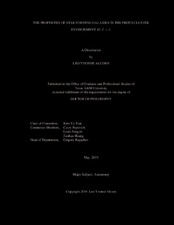| dc.description.abstract | Galaxy clusters are regions of the universe which host extreme gas physics, and allow us to probe fundamental physical properties such as dark matter, structure formation, and
baryonic properties. In the local universe, galaxy clusters host a population of galaxies
distinct from isolated galaxies. They tend to consist of galaxies with quenched or low star
formation, older stellar populations, low gas fractions, higher levels of velocity dispersion,
and elliptical shapes. In less dense areas of the universe, the fraction of galaxies with ordered
rotation, higher star formation, disky morphology, and high gas fractions increases. At z ~ 2,
galaxies in clusters and proto-clusters are still at a stage of rapid star formation and are not
yet quenched. We observe two galaxy proto-clusters at z = 1:62 and z = 2:095 to measure
the kinematic and nebular gas properties of galaxies in these forming clusters.
We perform a kinematic and morphological analysis of star-forming galaxies at z ~ 2
in the COSMOS legacy field using near-infrared spectroscopy from Keck/MOSFIRE and
F160W imaging from CANDELS/3D-HST. Our sample consists of cluster and field galaxies
from 2:0 < vz < 2:5 with K band multi-object slit spectroscopic measurements of their
H∞ emission lines. We measure H∞ emission-line integrated velocity dispersions (Óvint) from
50 -- 230 km s^-1, and from these data we estimate virial, stellar, and gas masses and derive
correlations between these properties for cluster and field galaxies at z ~ 2. We find
evidence that baryons (gas and stars) dominate the mass within the central effective radius.
However, we find no statistically significant differences between the cluster and the field,
and conclude that the kinematics of star-forming galaxies at z ~ 2 are not significantly different
between the cluster and field environments. H∞ rotational velocities and gas velocity
dispersions are measured using the Heidelberg Emission Line Algorithm (HELA), which
compares directly to simulated 3D data-cubes. We examine the role of regular and irregular
morphology in the stellar mass kinematic scaling relations, deriving the kinematic measurement
Sv0:5, and finding log(vS0:5) = (0:38 ± 0:07) log(Mv⋆/Mv⊙- 10) + (2:04 ± 0:03) with no
significant offset between morphological populations and similar levels of scatter (~ 0:16
dex). We estimate the specific angular momenta (vjdisk) of these galaxies and find a slope of
0:36 ± 0:12, shallower than predicted without mass-dependent disk growth, but this result
is possibly due to measurement uncertainty at M?< 9:5. However, through a K-S test we
find irregular galaxies to have marginally higher vjdisk values than regular galaxies, and high
scatter at low masses in both populations.
We measure the properties of ionized regions in galaxies in the UDS and COSMOS
proto-clusters by measuring fluxes from emission lines Hβ4861Å, [OIII] 5007Å, H∞ 6563Å,
[NII] 6585Å, and [S II] 6716,6731Å. We measure gas-phase metallicity of both protoclusters
using two metallicity indicators, including an indicator independent of ionization
parameter and electron density, finding that cluster and field galaxies in both UDS and COSMOS
lie on the same Mass-Metallicity Relation. We find tentative evidence (~ 2vÓ) that
galaxies in clusters have lower [OIII]/Hβ-ratios (~ 0:2 dex) relative to the field. However,
we are limited by small numbers in the clusters and contamination by sky lines in measuring
Hβ. Results indicate that galaxies in proto-clusters have lower ionization parameter than
field galaxies at similar redshift and stellar mass, possibly due to the development of the hot
intracluster medium. | en |


